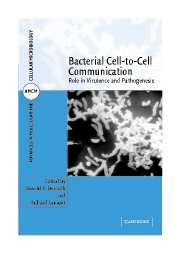Book contents
- Frontmatter
- Contents
- List of Contributors
- Preface
- 1 Quorum sensing and regulation of Pseudomonas aeruginosa infections
- 2 The Pseudomonas aeruginosa quinolone signal
- 3 Quorum-sensing-mediated regulation of plant–bacteria interactions and Agrobacterium tumefaciens virulence
- 4 Jamming bacterial communications: new strategies to combat bacterial infections and the development of biofilms
- 5 Quorum-sensing-mediated regulation of biofilm growth and virulence of Vibrio cholerae
- 6 LuxS in cellular metabolism and cell-to-cell signaling
- 7 LuxS-dependent regulation of Escherichia coli virulence
- 8 Quorum sensing and cell-to-cell communication in the dental biofilm
- 9 Quorum-sensing-dependent regulation of staphylococcal virulence and biofilm development
- 10 Cell-density-dependent regulation of streptococcal competence
- 11 Signaling by a cell-surface-associated signal during fruiting-body morphogenesis in Myxococcus xanthus
- Index
- Plate Section
- References
4 - Jamming bacterial communications: new strategies to combat bacterial infections and the development of biofilms
Published online by Cambridge University Press: 08 August 2009
- Frontmatter
- Contents
- List of Contributors
- Preface
- 1 Quorum sensing and regulation of Pseudomonas aeruginosa infections
- 2 The Pseudomonas aeruginosa quinolone signal
- 3 Quorum-sensing-mediated regulation of plant–bacteria interactions and Agrobacterium tumefaciens virulence
- 4 Jamming bacterial communications: new strategies to combat bacterial infections and the development of biofilms
- 5 Quorum-sensing-mediated regulation of biofilm growth and virulence of Vibrio cholerae
- 6 LuxS in cellular metabolism and cell-to-cell signaling
- 7 LuxS-dependent regulation of Escherichia coli virulence
- 8 Quorum sensing and cell-to-cell communication in the dental biofilm
- 9 Quorum-sensing-dependent regulation of staphylococcal virulence and biofilm development
- 10 Cell-density-dependent regulation of streptococcal competence
- 11 Signaling by a cell-surface-associated signal during fruiting-body morphogenesis in Myxococcus xanthus
- Index
- Plate Section
- References
Summary
INTRODUCTION
The growth and activity of microorganisms affect our lives in both positive and negative ways. We have, since early times, tried to combat unwanted microbes and utilize those expressing useful traits. Microorganisms can cause diseases and chronic infections in humans, animals, and plants. In medicine, agriculture and fish farming, treatment scenarios are based on antimicrobial compounds such as antibiotics, with toxic and growth-inhibitory properties. Control of growth by eradication of bacteria is one of the most important scientific achievements. Unfortunately, bacteria have become gradually more and more resistant to antibiotics, and infections caused by resistant bacteria are on a dramatic increase. It has recently become apparent that the bacterial lifestyle also contributes significantly to this problem. The traditional way of culturing bacteria as planktonic, liquid cultures imprinted the view that bacteria live as unicellular organisms. Although it must be emphasized that such test-tube studies have led to fundamental insights into basic life processes and have unraveled complex intracellular regulatory networks, it is now clear that in nature microbial activity is mainly associated with surfaces and we as scientists must therefore turn our attention to this sessile mode of growth (33). It appears that the ability to form surface-associated, structured and cooperative consortia (referred to as biofilms) is one of the most remarkable and ubiquitous characteristics of bacteria (12). In this sessile life form, bacteria can cause various problems in industrial settings, ranging from corrosion and biofouling to food contamination.
- Type
- Chapter
- Information
- Bacterial Cell-to-Cell CommunicationRole in Virulence and Pathogenesis, pp. 65 - 100Publisher: Cambridge University PressPrint publication year: 2006
References
- 1
- Cited by



